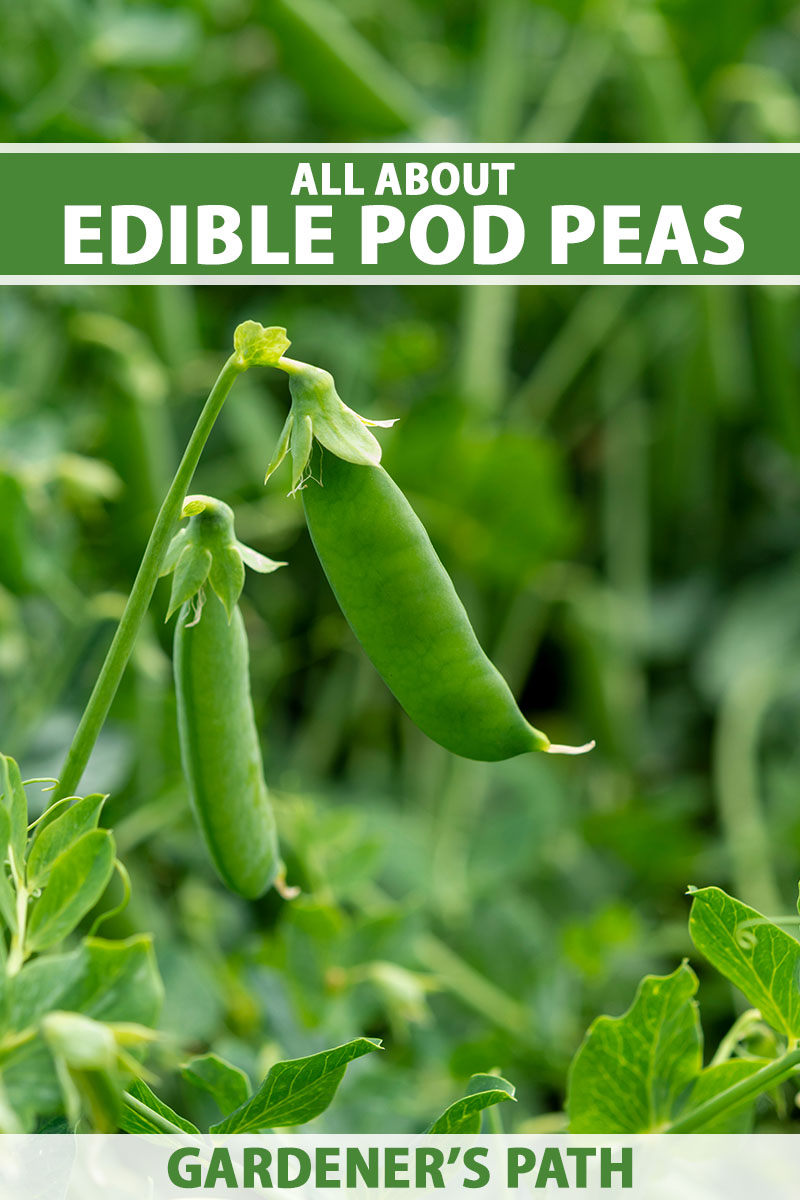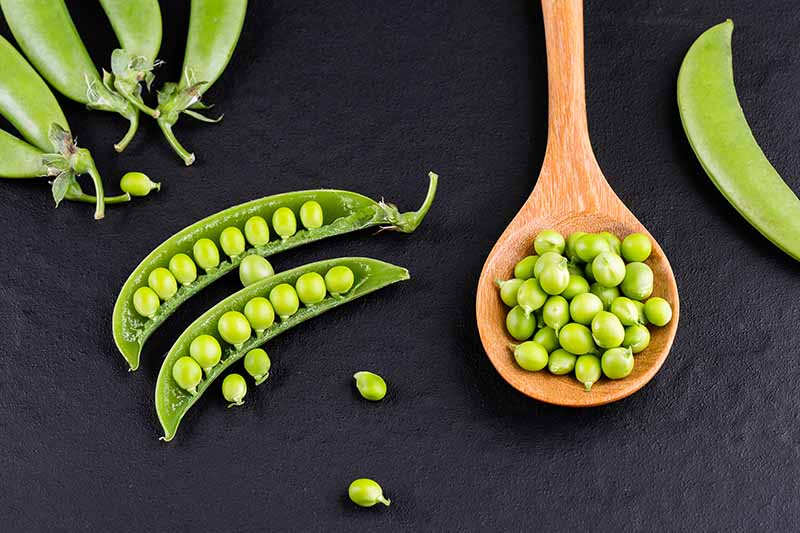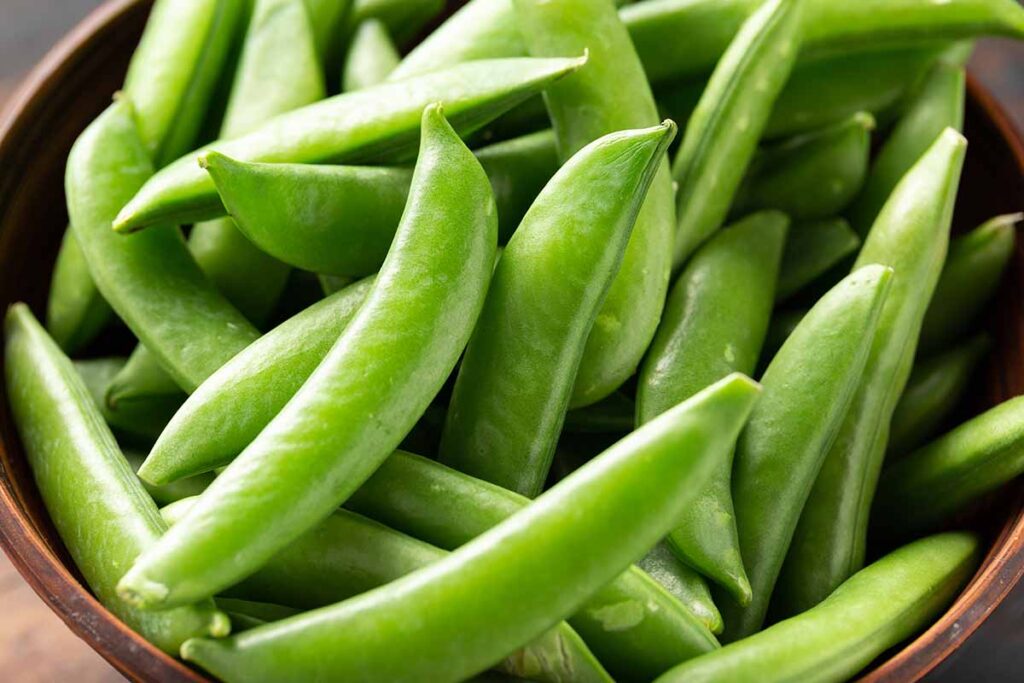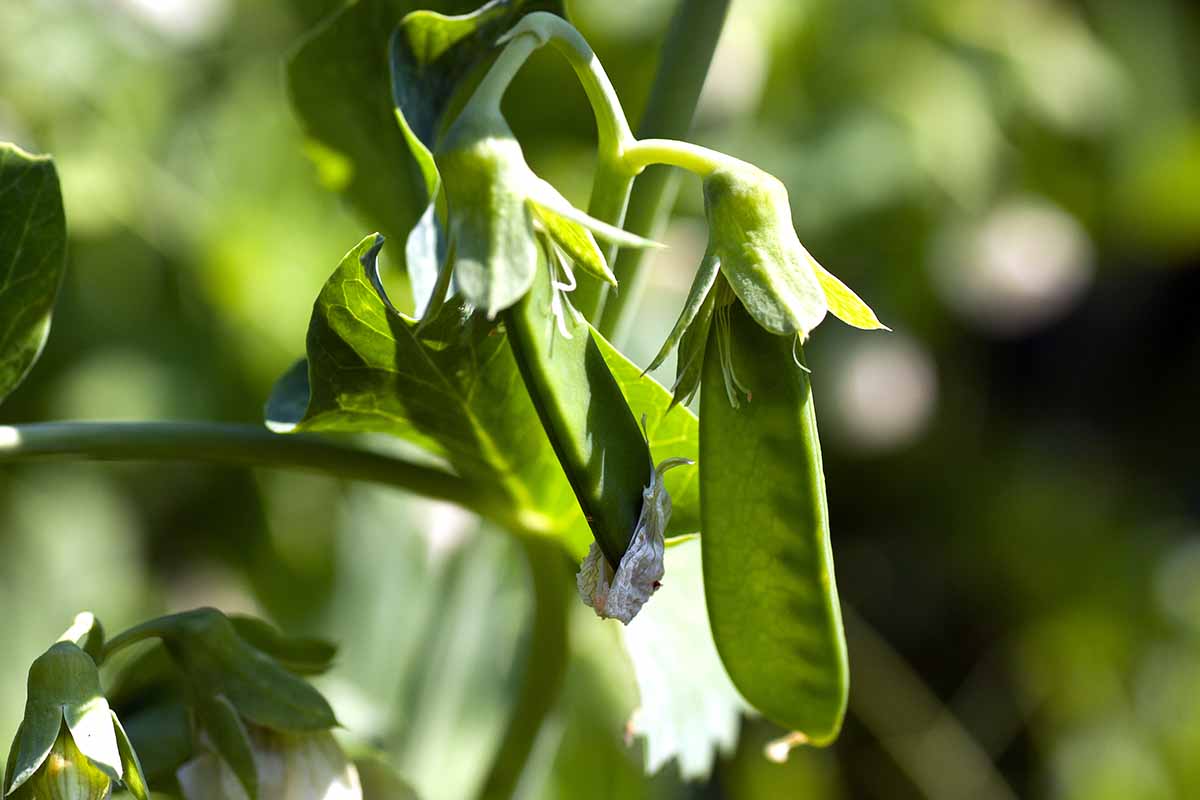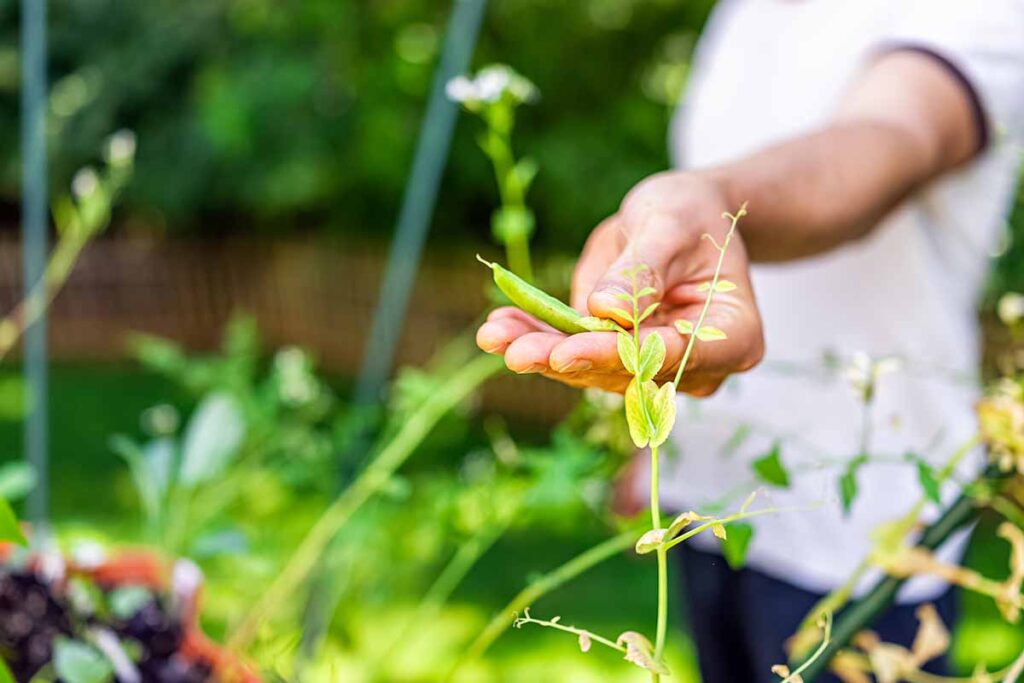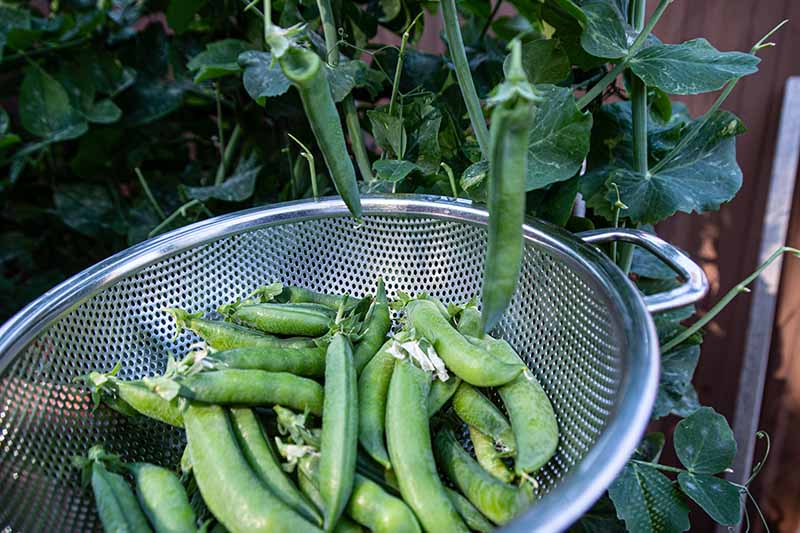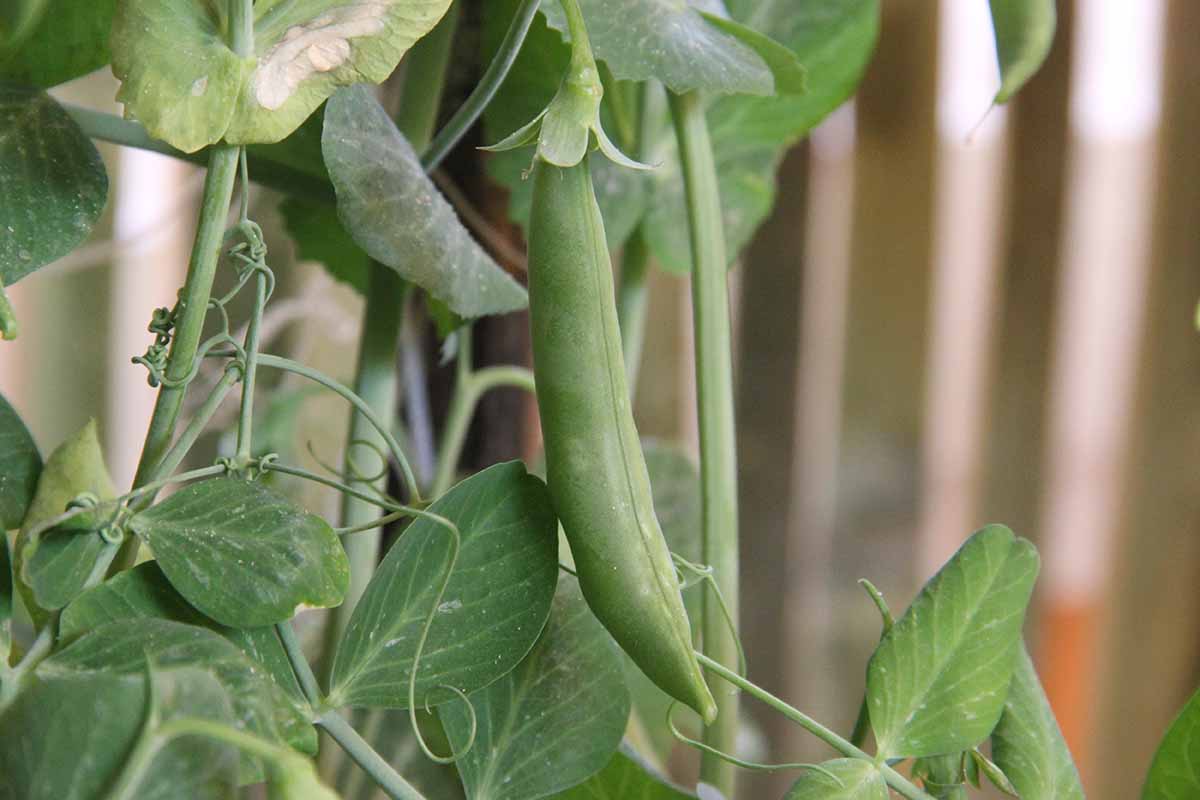Of course, you can also bring the harvest indoors to store in the fridge and eat later as crudite, or toss in salads. In the case of the snow peas, they’re also delicious in stir fry. But these crisp, sweet snow or snap peas are essentially a simple pleasure, a nutritious legume best enjoyed fresh or cooked only briefly. We link to vendors to help you find relevant products. If you buy from one of our links, we may earn a commission. I’m going to explain the distinction between the varieties with seed pods you consume whole and the shelling varieties, which are also known as English peas. By the time we’re done, you’ll have ample information to help you decide whether this might be a veggie you want to grow in your garden, or if another legume or cool-weather option might suit you better. Here’s what to expect:
Edible Pod vs. Shelling Peas
There are two types of peas with edible pods, and both are members of the legume family and related to English peas. The distinction is that snow and snap peas (P. sativum var. macrocarpon) have been bred to be consumed pod and all. Shelling types have tough pods with inedible, fibrous interiors. In contrast, snow pea pods have thin walls that are tender and enclose teeny-tiny seeds. And snap peas have succulent, thicker walls and the seeds inside are plump, juicy, and crisp. Snap types are more rounded than snow peas, and their flavor is less vegetal, with a higher water content. Both types of edible pod peas are vitamin-rich and contain lots of fiber. They also deliver a smidge of protein, though English peas are a much better source of this macronutrient. Like all garden peas, these two legumes prefer cool-weather growing conditions and are one of the first veggies to produce a harvest in the spring. They can also sustain a little frost or even snowfall in early spring or late autumn. They’re a grazer’s delight, and kid-friendly too. Need more convincing that this legume deserves a spot in your garden? Keep reading to learn more about the benefits and desirable traits of these plants.
Snap Pea Basics
Also known as sugar snaps, these are the most recent entry into the world of edible pod peas, developed by breeder Calvin Lamborn in 1979 as part of his research into straighter, more commercially viable snow pea pods. Lamborn’s introduction crossed snow and English peas, with the result being a juicy, crisp, rounded pod full of tender, sweet seeds. This darling of the crudite tray is intended to be eaten pod and all. Some varieties are stringless, while others develop strings that can be consumed or removed before cooking or consuming. It is possible to harvest these pods in their early stages before they develop plump seeds. You can eat or cook the flat pods, but they aren’t as structurally sound as they are when picked later, so they tend to become mushy in stir-fries.
Snow Pea Basics
These are also often referred to as Chinese pea pods. This specific type has been around since the 1500s. One popular cultivar is the hybrid ‘Sugar Sprint,’ an early variety that produces three-inch pods starting 58 days after sowing. The plants grow just two feet tall and don’t need support. ‘Sugar Sprint’ This cultivar also resists powdery mildew and can keep producing for a couple of weeks in early summer, before the arrival of hotter temperatures. Find ‘Sugar Sprint’ seeds in various packet sizes and sacks up to five pounds at True Leaf Market. The plants produce flat pods that are crisp and sweet. The seeds inside are tiny, even at maturity. Each of the “big three” types of garden peas includes both compact and long-vine varieties you can plant, and it’s a good idea to pick one that suits the length of your growing season and your available space. ‘Mammoth Melting’ is one of the most popular varieties to grow in the home garden. It starts forming four- to five-inch pods 68 days from sowing, and grows on vines that need support and reach four or five feet tall. ‘Mammoth Melting’ Find ‘Mammoth Melting’ seeds in various-size packets and 25-pound sacks at True Leaf Market. Learn more about growing and caring for snow pea plants in our guide.
Growing Tips
While the tender, three-inch pods that grow on ‘Sugar Snap’ and ‘Sugar Bon’ cultivars look and taste about the same, for example, the plants they grow on are quite different. ‘Sugar Bon’ reaches just 12 to 24 inches long and matures in a super-fast 56 days. It’s ideal for container gardeners or anyone in areas with cold weather in the springtime or early-onset summer heat. ‘Sugar Snap,’ on the other hand, takes 70 days to start producing, and grows on six- to eight-foot vines. It’s a better choice for those with more time before spring weather gets hot, and gardeners who want to save space by growing their plants aerially, on vertical supports. Once you’ve settled on a suitable cultivar, edible pod types share growing requirements with the other types of P. sativum. These shelling, snap, or snow peas all need full sun, well-draining soil amended with plenty of organic material, and a pH between 6.0 and 6.8, or just a bit acidic. You’ll want to sow the seeds six weeks or so ahead of the last average frost date in your area, and plan to complete your harvest before temperatures exceed 85°F. All these varieties can withstand light frost and even snow, but heat is their enemy. Production will slow as the temperatures climb, and the plants will start dying as soon as summertime temperatures hit 85°F and above. Unless the seed packet for your chosen cultivar specifically states otherwise, give your plants some support with bamboo stakes, netting attached to posts, or a trellis. This is an absolute must for tall vines, but even the ones that will attain just 18 to 24 inches in height can benefit from support to guide the plants to grow towards the sun, and keep the fruits off the ground. Make sure to keep the plants well-watered but never soggy, supplementing with about an inch of water per week when the rain doesn’t provide what the plants need. To retain water and suppress weeds, mulch when the seedlings are a couple of inches tall, being careful not to disturb the roots. You can learn more about growing and caring for peas in our guide.
Timing the Harvest
Every homegrown vegetable benefits from being harvested at its peak, but the strategy is particularly important for snap and snow peas. It will only affect the taste a little if you harvest undersized edible pods, so don’t worry too much if that’s your best option ahead of vacation – or if you’re just getting impatient! Full-size pods aren’t as tender, but they are a bit sweeter than the little guys at harvest. Whatever you do, aim to pick before the pods get too big. Overgrown snow pea pods can be brittle and starchy. And while you can slit them and ease out the tiny seeds, they’re only just palatable, not sweet or crunchy. And since they’ve been bred to be eaten without shelling, the pods are intended to stay in one piece, which means it’s laborious to try to separate those tiny, edible bits. In my experience – and sadly, I do have experience with overgrown pods – it requires a very sharp knife and a lot of patience to liberate even a few seeds from the flat shells. Much better to harvest on time! While it’s not 100 percent reliable due to variable germination rates and conditions in one’s own garden, the seed packet should give you a good idea of when to expect mature pods. Post a reminder on your cell phone or in your gardening journal to start looking for edible pods about 10 days ahead of your variety’s published number of “days to maturity.” For optimal taste and to encourage more pods to form, pick when the pods are the right size for the particular cultivar you are growing, or once they plump out but before you can see the outline of the seeds inside for sugar snaps. If some have become overgrown, be sure to clip them from the vines and toss them in the compost, so the plants don’t start devoting their energy to forming dry seeds. In most cases, new pods will form quickly, as long as the growing conditions are still favorable.
Cooking Ideas
Once you’ve eaten your fill of fresh-from-the-vine edible pods, you can turn to numerous ways to employ this veggie in recipes. Keep in mind that this type of legume does not do well with slow or extensive cooking. Instead, they require just a kiss of heat, and maybe a plunge into cold water afterward before you proceed with a recipe. Leave the stewing, braising, and slow-cooking for green beans or dry legumes. Snow peas are delicious in stir fry and enhance spicy, saucy, vegetable-based dishes like five-ingredient Thai curry in a hurry. Find step-by-step instructions to make it at home on our sister site, Foodal. When they’re no more than a couple of days old and still at their crisp, sweet best, either type makes a tasty addition to the crudite tray or charcuterie board. Because they’re so light and sweet, you’ll want to pair them with a dip that isn’t too overpowering. The light, fresh texture goes particularly well with creamy dips that are lively, but not too hot, like this corn and cream cheese dip with cherry tomatoes from Foodal. Snap peas need even more TLC in the kitchen than their flat-pod brethren. It’s far too easy to turn them to yellow or gray-tinged mush by overcooking. Instead, to use them in dressed salads or marinated side dishes, be sure to only lightly steam them and then plunge them into a bowlful of ice water to stop the cooking, a process known as blanching followed by shocking in an ice bath. At that point, they’ll be a sprightly green and tasty while retaining their crisp texture, complemented perfectly by any number of Asian sauces or light, fruity vinaigrettes. Once they’re blanched, you can heat them quickly in a sauce or add them to pasta salad or marinated veggies. You can also use snap peas to make lacto-fermented pickles. If you’re not familiar with the process, get your bearings with this recipe for lacto-fermented dill pickles from Foodal. Or try Foodal’s recipe for lacto-fermented salsa. Use a handful of snap peas in place of a portion of the green vegetables and you’ll have a hit on your hands. Even though I realize other family members and those in my circle of homegrown produce-loving friends would also enjoy part of the harvest, I’ve been known to eat most of it during strolls through the garden on late spring evenings. Oops! When I find I don’t have enough to share, I always make sure to plant a few extra seeds the next time I sow, in successive plantings. Are you already familiar with these plants, or perhaps thinking of growing them for the first time this spring or fall? The comments section below is open for questions or suggestions from veteran growers and newbies alike. The Gardener’s Path community appreciates your input! And if you found this tutorial helpful, consider reading more of our pea growing tips. Check out these guides next:
17 of the Best Shelling Pea Varieties to Grow in Your GardenHow to Identify and Control Pea Weevils
